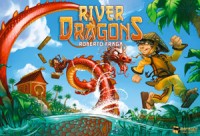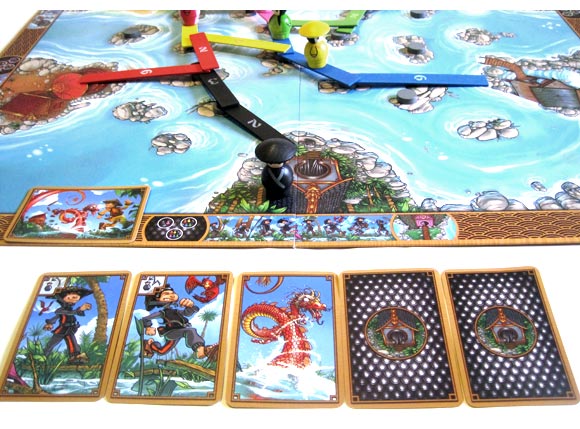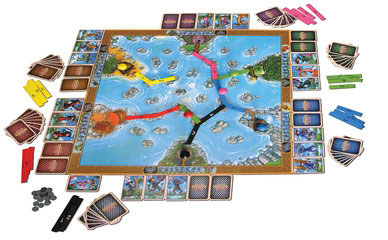
River Dragons

Family Focus Review
These reviews provide insight on some of the best games for families with young gamers. Written from a parent’s perspective for a fun and educational family game night!
Overview
In River Dragons, you are a young hopeful from your village trying to be the first to cross the river and receive a golden dragon from the King himself. Players in turn choose 5 action cards that dictate what they do during the turn. You can place stones in the river, place a plank or two on the stones and even take away other player’s planks. But dragons can rise out of the river and cancel other players’ actions! Negotiate your way across the river to the opposite village and you win!

Set Up
The game board is placed on the table and each player chooses a starting village printed around the edge of the game board. Players take the deck of cards that matches the color of the village they chose. Each deck contains 8 action cards and one dragon card that matches the other players’ colors. (With less than six players, you simply leave out the dragon cards for the unclaimed village colors.) Each player also takes 6 wooden planks numbered 1-6 that match their village color. A pile of “stones” is placed nearby and the youngest player takes the “first player” token. Ready? Set? Go!
Gameplay
There are only two game phases in River Dragons: the Programming Phase and the Action/Resolution Phase .
Programming Phase:
Each player chooses five cards from their hand and places them on the table in front of them from left to right in the order that player want the actions to occur. These are the actions a player can choose:
- Place 1 Stone – on an Island of your choice that doesn’t already have one.
- Place 2 Stones – on 2 islands of your choice as above.
- Place 1 Plank – between 2 stones. The Plank has to reach in length from one stone to another. If a Plank wont fit, it falls into the river and is lost!
- Place 2 Planks – as above.
- Remove 1 Plank OR 1 Stone – If a player must remove a plank it has to be a number that they don’t have in reserve.
- Move 1 – Move you player pawn from one plank or village space to another but only if it’s unoccupied. If you cannot move legally, you fall into the river!
- Move 2 – Move 2 spaces as above.
- Jump – Over another pawn that’s in your way. Again if you can’t, you fall in the river!
- Dragon – Playing a dragon card of a certain color cancels the action taken by the player of that color on this round.
Once the chosen cards are placed, they cant’ be moved.

Action/Resolution Phase:
During the Action/ Resolution phase, everyone reveals their first (farthest left) card at the same time. Then in player order, they are resolved (if possible). Once all players have taken their first action, the second card from the left is flipped for all players and play continues. This happens in player order for each card placed.
Once all 5 cards are flipped in the current round, The first player marker passes to the next player clockwise and players again choose 5 new cards for the next turn.
The game ends as soon as one player’s pawn safely reaches their destination village. That player wins and received a golden dragon from the King!
Components
One of the key attractions of this game is the family-friendly, cartoon-esque artwork with the wonderfully crafted components. The planks and pawns are made of wood and add to the simple, almost ancient ambience of the game.

Learning Curve
A game for ages 8 and up, the game is easily taught and played by this age group – and perhaps even younger depending on your child’s development.
Educational Value
River Dragons will help develop:
- Eye-hand coordination
- Strategic planning
- Decision making
- Player interaction
- Memory
- Patience and perseverance
River Dragons requires no reading skills. Each of the action cards adeptly pictures what effect that card has in the game. The vibrantly color-coded and numbered planks make the game visually easy to follow even for children as young as 6. But as you will see the game will test younger players in other ways.
For The Parent
River Monsters is easy to learn and is a good game for the kids, but the game’s mechanics can create a frustrating experience as well. The Programming and Action/Resolution phases each present a challenge for you as a parent in helping them succeed. Here are some tips:
- Even though the cards themselves have no text and depict the players’ actions clearly with illustrations, choosing the incorrect move may frustrate younger players. When a player makes a wrong move and “falls into the river,” that player must begin their next turn at their starting village. Like the game Sorry!, too much of this and a younger players will give up an move on to greener pastures. This is best handled with humor and a casual attitude. Take the game too seriously and your kids will too.
- Younger players must also balance the decision to play a card that advances them across the board, or in the case of “Remove a Plank/Stone” and the Dragon cards, whether to impede the other players. The latter is irresistible, even for adults. Children may need reminding that winning the race is the goal, not making other players lose. Keep it positive.
- During the Action/Resolution phase, the real charm of the game: the building of the plank bridges in 3-dimensions, can also be a downfall for younger players (and even grown-ups!). Three planks (the maximum) stacked on a stone are a bit unstable. Even though this is exactly the sort of tension and unpredictability that makes the game immersive, one accidental bump of a set of planks and the construct will tumble leaving everyone to sort it out. Parents may want to place the planks for the very youngest children, encouraging them in their choice, just to fend off inadvertent frustration or embarrassment.
Final Thoughts
Originally released in 2000 as Dragon Delta, River Dragons is in essence a simultaneous action selection game. Like the classic Robo Rally players “program” their turn in advance, and like Robo Rally, chaos ensues. This game, however, is very accessible to children and families in that the “chaos” is less adversarial and more… comical.
Overall, the game is charming and the artwork and design are very appealing. On a shelf next to other games, it simply beckons to be played. Reasonably easy to set up and begin, little explanation is needed even for the youngest of players. As game play progresses, everyone can immediately see the “collision” that is about to occur. With each player needing to get to the opposite side of the board to win, everyone very quickly gets in everyone’s way – blocking moves, stepping on other players’ planks and removing planks and stones to thwart the advance of the other players. Playing Dragons on other players always causes a groan, but you play them at the expense of advancing your own game.
From a complexity standpoint, every action card does have its specific limitations and consequences if it is played incorrectly. For example, a player cannot play a “Remove a Plank” action card unless they are missing that same numbered plank from their inventory. If not, the action is lost. The “Jump over another Pawn” is the most difficult action to play as the conditions must be perfect – otherwise “plop” you’re in the river and back to start. Many time the players will find – though no fault of their own – that their chosen action cannot be done. And this is the real action that the game provides. Chaos. The simultaneous action selection of 5 different cards in 5 different turns creates an amazing emergent interaction that is not random – but certainly seems that way. This unpredictable behavior of the game may cause frustration. The key is how you and your children are able to handle this.
Frustration is often a difficult emotion to negotiate in a game. After all, games are supposed to be fun. Even adults don’t always handle frustration well in games. So in this game parents have a real opportunity to set an amazing example of patience and learning how to “roll with the punches” (or “dragons” as it were). Good humor must be a part of the game as many, many times the moves that a player wants to make, cannot be achieved through the player interaction on the plank network. Helping younger players along with turn planning and even at times, plank placement will create a more enjoyable experience for everyone. And in this game, you must keep your eye on everyone. As soon as the chaos can ensue, a winner will hop right down off a plank into the winning village.
The mechanics and emergent behavior that River Dragons presents creates a truly enjoyable game experience and a great replay value. Asmodee has done well to reissue the game. A hidden gem for the family and even casual adult gamers!
User Reviews (3)
Add a Review for "River Dragons"
You must be logged in to add a review.



In brief: great, simple, and gorgeous game to play with up to 6 players with social, family, and even some strategy gamer archetypes. Lasts about 30 minutes and usually has some frustrating as well as hilarious moments. May be a good game to teach young-at-hearts good sportsmanship as well as some basic strategy.
Not in brief: In River Dragons (not Delta Dragons), you’ll first notice how strikingly beautiful the artwork and the quality of the game board, pieces, and cards are. Like Chinese checkers, your job is to get your color meeple (marble) from your island (corner) to the other side’s island (corner) while using the spaces and other player’s pieces along the way in between. Like Robo Rally, you have to “pre-program” your actions in advance using 5 of 13 unique action cards. The order of actions is based on clockwise turn order, and you tend to have more flexibility than the more logical/rigid Robo Rally. Lastly, it’s similar to Mother Sheep in that you use colorful wooden planks and some fine (or in my case, not-so-fine) finger motor skills to create a 2-D grid of pathways connecting the various islands.
Gameplay. See above. There are some details not mentioned above that make this a bit more strategic. When placing a plank, you can’t take it back to try another, so you need to choose carefully. Stones are not to be nudged or moved after being placed. When you remove a plank, not only must it be a number you don’t have in reserve (so you’re encouraged to play more planks than you remove), you can’t have more than two colors in reserve so this limits you further on your opportunities for destruction. You can place pieces anywhere on the board, even if they are far from where you are. Each stone can only have up to 3 planks connect to it, so sometimes you should add a useless plank only to stop others from using those same stones.
Quality. The game board is very large and double-sided (beginner and advanced sides). We didn’t have space to set our cards out on our tables, so we stacked them on top of each other. You lose a little information for strategy this way, but it speeds up the game a bit. Everything is top quality – the updated artwork, the board, planks, and cards. The only item we wish we could improve were the stones. Having them made of something heavier so they wouldn’t be so easy to accidentally move would be very helpful, especially on the advanced board that isn’t restricted to islands.
Experience. Depending on your experience, it’s possible to have a winner on the second full turn (each turn has 5 actions/rounds). This happened with us, and our second game was much slower as everyone worked to prevent anyone else from winning. The ability to place and remove planks and stones anywhere while being very slow to actually move the meeple makes the theme somewhat hard to relate to (questions like:”If I could magically drop a stone over here, why can’t I magically get to the other island? And why does my guy need to be limited to 5 pre-programmed actions?”). There were several times where our meeples, planks, and stones fell over and we had to replace everything – usually after we stopped laughing. The chaos that comes from pre-planning usually results in inefficiencies, inaction, and jumping in the river only to start over again. Winning often just feels like you got lucky with the right card played while others didn’t negate you by playing a dragon of your color. There are only 2 direct ways of moving forward and 1 additional requiring a jump, so it’s often a slow pace wins the race. The first one to their island wins immediately, which prevents any ties even if they would have also won on the same round of the turn.
Still, this is a gem for social and family players – easy to learn and play, and often results in feigned frustration and laughter.
This game was on my to-have-list for quite a few years, and now that a new version was released I bought it right away. I was very pleased to see that they had pimped many of the components, and the cards artwork is great. The only concern I have is their choice of colours, it’s not hard to confuse the red player with the pink player for instance.
Each player lives on a piece of land next to the border of the gameboard, and the winner is the first to get across the system of islands and make it safely to the other side. Sounds easy? Think again.
Each turn you program your actions (not unlike RoboRally, but here you always have the same 13 different cards to chose from. Some cards allow you to place rocks on the islands, other cards let you place or move bridges between those rocks. Some cards let you walk and one card even let you jump over another player and land on the bridge on the other side. Finally there are dragon cards in all other players colours that you can use to make them skip one of their cards this turn (only one dragon may be played per player each turn).
The board gets crowded pretty quick, and each stone can only hold three bridges (so building additional bridges to hinder opponents can be quite effective). And here comes the chaos! The rules basicly says that as soon as you try to move your pawn and it is not possible to do that you will fall in the water, and have to start over again the next turn on your home island. It’s VERY hard to exercise any real strategy, the randomness of your fellow players actions make sure of that. However, I don’t think that’s a problem, in fact it is part of the charm with this game. This is a fairly short game, and I don’t think tha author meant it to be taken seriously.
I think you should try it out. Really serious gamers may be frustrated over the randomness, but we found it to be appreciated by a wide range of people. And taking a swim is not the end of the world, you just start over again…
What Is It?
You probably read the summary before you looked at this review. Go look there for better details. In short, you select actions 5 at a time trying to get your villager from his island to the one across from him/her. You have to do things like lay stones, planks, walk, run, leap and summon the river dragon to help your cause.
Why does it work with the kiddies?
The game is a very simple concept, sets up quickly and very colourful. That in itself should draw in the little ones. There are no words so my daughter has been able to play it since she was four. Once they understand what all of the cards mean, they will be a formidable opponent. In my experience, kids will attack adults with River Dragons with EXTREME prejudice!
It is also a very tactile game. Where you lay your stones and planks is an important part of playing. Those little touches help get everyone involved.
But what about me, and the other mature adults in the group?
As mentioned elsewhere, there are definitely elements of Chinese Checkers and Robo Rally. This means that there’s a lot of opportunity for interaction and you’re frequently faced with the choice of playing for your own game, or running interference on someone else.
Since the kids are up to speed, the high interaction should allow for lots of fun re-playability. Your opponents will set the level of strategy, but there’s ample opportunity to mess with each other so it can get quite thinky or nasty. Since actions are revealed simultaneously the wait times are not bad at all.
This sounds too good to be true!
It’s not without it’s faults. It’s sort of cartoony and that may make it a hard sell if you’re pulling it out for adults. The simplicity may mean there’s only so many times that you want to play (at least until you’ve had some respite.) The planks are very fragile and it’s not uncommon for them to get knocked off of the stones throughout the game (especially by little hands.)
All in all though, I’ve really enjoyed pulling this out with the family. It is also a good warm up or gateway game. I recommend it for an fun light experience.